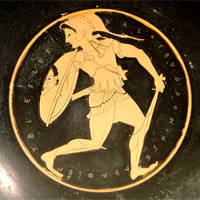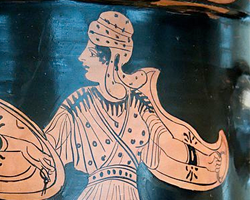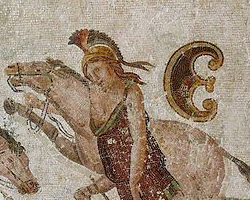
This page created 30 August 2014, and last modified: 19 July 2015 (Maier reference numbers added)

The Secunda Felix Valentis Thebaeorum is listed (15.23 in Ingo Maier's numbering scheme) as the eighth of the nine legiones comitatenses under the Magister Militum per Orientem. Its shield pattern (14#5), as shown in various manuscripts under the matching label (14.e) Secunda Felix Valentis Thebaeorum, is as below:

The shield pattern is relatively complex. Its basic form is a white main field bearing a red cross. Flanking the bottom arm of the cross are the forequarters of two horned bovids in red (brown in M, B), facing outwards. The rim is white (but red in B), while the boss is yellow (white in M, W). Surrounding the boss is an unusual design in red, which looks like a circle with two deep lobes cut out at approximately the 11 o'clock and the 1 o'clock positions. This would appear to be a mythological Amazonian shield.

|

|

|
|
|
|
|
|
|
|
|
As can be seen from the above, Amazons, despite being mythologically located to the north-east, were first conceived by the Greeks as being armed like contemporary Greek warriors; in the 6th century, this meant a heavy Argive shield as depicted above-left. After the Persian invasions, however, Amazons were depicted with light crescent-shaped peltae as carried by the appropriately-located Scythians, although they frequently were shown with a slight "bump" in the middle of the convex section that real peltae did not seem to share, as shown in the middle picture above. This bump seems to have steadily grown, so that by the start of the 3rd century, it could be shown as a central "stalk", as shown above-right, and also corresponding to the motif shown in the Notitia; geographically appropriate for a unit assigned to Rome's most eastern field army.
The pattern of the Secunda Felix Valentis Thebaeorum is thus almost identical to that of the next unit in the Magister Militum per Orientem's list: the Prima Flavia Theodosiana (15.24), which differs only in substituting canids for bovids; the strange central device is also borne by the next two units in the same command, the Prima Armeniaca (15.26) and the Secunda Armeniaca (15.27). Outside of the Magister Militum per Orientem's command, it is carried by only two other units: the Menapii (18.13), under the Magister Militum per Thracias, and the unit that is said to be (12.28) the Sagittarii seniores Orientales, under the Magister Militum Praesentalis II. All six can be compared below, using the patterns taken from the Parisian manuscript:

The unit itself would appear (see below) to be a detachment of the Legio secunda Valentiniana (56/7.18) under the Dux Thebaidos, and according to the Notitia stationed at Hermunthi, i.e. Hermonthis, modern Armant, near Thebes - modern Luxor in Egypt. 4th century papyri record a detachment at Oasis Magna, which in the Notitia is the station of the Ala prima Abasgorum (56/7.20,34), at modern Al-Kharijah/Kharga, and another from nearby Trimithis-Oasis minor (modern Dakhilah/Dakhla), which in the Notitia is the station of the Ala prima Quadorum (56/7.35).
Legio II Valentiniana may have been created by Valentinian I (reigned 364-375) along with Legio I Valentiniana, also (56/7.15) listed under the Dux Thebaidos. They are perhaps less likely to have been old units merely renamed during his reign, as the only usurper during his reign, Procopius, does not appear to have raised any new units, and the units he is recorded by Ammianus as bringing over to his cause are all attested with their names in the Notitia. Creation under the young Valentinian II is also a possibility (375-392), but unlikely given he was in the west, and until 383 was very much a minor influence under Gratian (and there are already seemingly too few units named after Gratian), while from 379 the Eastern Augustus was the more vigorous Theodosius. Valentinian II did, however, suffer from a major usurpation, the 5-year rebellion of Magnus Maximus, who came from Britain. It is possible that these two units were ex-units of Maximus': as he controlled not only Britain, but at one point Spain, Africa and Gaul and almost all of Italy as well, they need not be British units. However, the stationing of the Ala quarta Britonum (56/7.24) under the Dux Thebaidos strongly suggests that they could be.
When the Secunda Felix Valentis Thebaeorum was split off from its parent unit cannot be ascertained for certain, but Zosimus (IV.30-31) records Theodosius mixing up northern troops with the Egyptian garrisons both in Egypt and in Macedon/Thrace in the late 370s/early 80s, which was then being devastated by the Goths; this was before the creation of the command of Magister Militum per Orientem, which occurred later in his reign, after he turned his attention away from the Balkans (according to Zosimus (IV.27) the office of Magister Militum per Orientem was created essentially contemporaneously with the events in the Balkans, but most scholars agree this cannot be the case - see Burns, page 313, note 49, and pages 98-100 - and that the office was created perhaps 6 to 12 years later).
Nonetheless, since the Secunda Felix Valentis Thebaeorum is named Valentis (cf. the Tertii sagittarii Valentis, 9.31, under the Magister Militum Praesentalis I), and not Valentinianensis or similar, one needs to be alert to the possibility the unit was named after Valens, the brother of Valentinian I, and emperor of the east from 364 to 378.
If the above dating is correct, the unit could not have been one of the "Theban legions" that Ammianus refers (14.11.15) to as being stationed near Adrianople in Thrace in 354.

Return to the Notitia alphabetical unit list page.
Return to my Notitia index page.